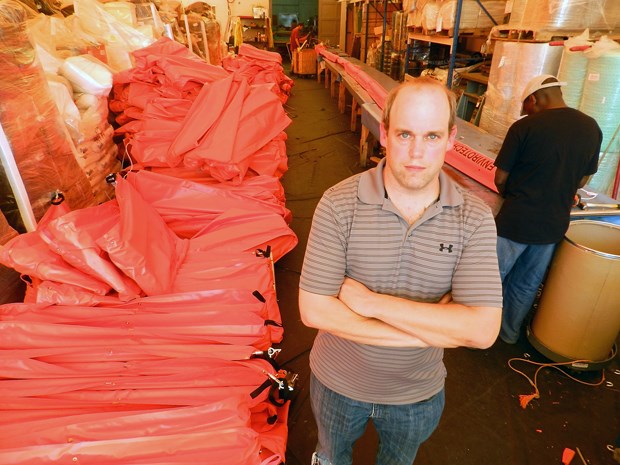If it was based mainly on the availability of equipment needed to mop up after an accident, John Jessup is confident the cleanup would go well.
“From our perspective, Canada has a tremendous capability for spill response,” said Jessup who, along with fellow owner Leo Rimanic, runs Richmond-based Canadyne Technologies Inc. which manufactures oil spill containment booms and oil skimming equipment for numerous clients, ranging from the Canadian Coast Guard to firms specifically tasked with cleaning up after an incident. “There’s been a lot of criticism in the media. But certainly, what we see from working with the spill response companies, they are well trained, well mobilized, and meeting their obligations quite well.”
That view meshes well with content in a report released last week on the aftermath of a bunker oil spill from a vessel in English Bay in April that employed several pieces of equipment Canadyne manufactures at its Vulcan Way facility.
One of the main conclusions pointed to a lack of coordinated communications among government agencies and the spill response agency that hindered efforts.
“I suspect that a lot of the work that needs to be done is not about (oil spill) equipment caches,” Jessup said. “Certainly, that’s important. You have to have the right equipment and have it close by. But a lot of it is communications because there are so many stakeholders involved.”
In the case of the English Bay spill, Jessup said there is Port Metro Vancouver, Canadian Coast Guard, WCRMC (Western Canada Marine Response Corporation — the spill response company), First Nations, and various levels of provincial and civic governments.
“It’s complicated for me, and I work in the industry,” Jessup said, adding the infrequent nature of spills also adds a layer to complicating the flow of information.
From the public’s perspective Jessup said he understands their frustration and confusion at why the situation cannot be better handled.
“We see the criticism from people who are not in the industry who ask, ‘why isn’t there spill equipment everywhere, and (spill cleanup) people everywhere?’ That would be fantastic for us if it was like that,” he said, adding spill response budgets can only stretch so far.
As for how a spill on the Fraser River would be handled, Jessup said there are even more variables to tackle than the English Bay incident.
English Bay has relatively calm waters while the Fraser River’s fast-moving waters presents a much different approach than simply surrounding the spill with a floating boom, Jessup said.
“Any time you have water flowing above one knot (1.688 feet per second) you are not going to contain it with a conventional boom perpendicular to the spill,” he said, adding that would be easily overcome. “It (oil) would go underneath the barrier.
“There has to be a different strategy to contain it.”
And that means not trying to stop the spill in its tracks, but deflect it, using an angled boom, to an area — possibly a shoreline — where it can be collected and recovered.
“The speed of the river adds complications,” Jessup said. “If you have a spill in a lake, you know where it’s going to be. You may be looking at wind and a little bit of movement of the oil, and natural spreading,” Jessup said. “In a river, if you have a spill upstream, where are you going to deploy your equipment? How quickly are you going to get that equipment into the water, and where?”
If you act too late, the oil could outrun any containment efforts, he added.
To arm the spill response companies, Canadyne manufactures booms with skirts of varying depths. They also manufacture booms that can be rapidly deployed and automatically inflated to provide a fast response time.
The array of products fills the Canadyne catalogue and is drawing steadily increasing interest from clients, said Jessup.
“It used to be the case that when we approached companies they’d say to us, ‘We’ll call you when we need something.’ It’s not like that now. Now, they want to see us all the time,” he said. “We’ve seen a lot more proactivity on the part of the clients to make sure they are keeping an eye on their spill response capability.
“All we’re trying to do is make sure the equipment is quick and easy to use, and safe.
“The rest is up to the spill response companies to get their actions right.”



